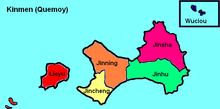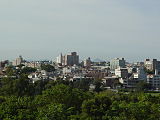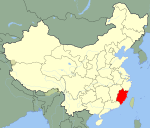- Kinmen
-
Kinmen County
金門縣
Abbreviation(s): Kinmen (金門; Pinyin: Jīnmén)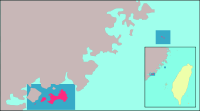
County seat Jincheng Region Southern Fujian County Magistrate Li, Wo-Shi (李沃士) Cities 0 Townships 6 Area - Total 153.056 km²
(20 of 25)- % water 0 % Population - Total 84,570 (December 2008)
(24 of 25)- Density 552.54/km² Symbols - County flower Four-season orchid - County tree Cotton tree - County bird Hoopoe Official websites www.kinmen.gov.tw Kinmen Traditional Chinese 金門 Simplified Chinese 金门 Literal meaning "Golden Door" or "Golden Gate" Transcriptions Mandarin - Hanyu Pinyin Jīnmén - Tongyong Pinyin Jīnmén - Wade–Giles Chin1-men2 - IPA [tɕínmə̌n] - Yale Romanization Jīnmén Min - Hokkien POJ Kim-mn̂g Cantonese (Yue) - Jyutping gam1 mun4 Kinmen County Traditional Chinese 金門縣 Simplified Chinese 金门县 Transcriptions Mandarin - Hanyu Pinyin Jīnménxiàn - Tongyong Pinyin Jīnménsiàn - Wade–Giles Chin1-men2hsien4 - Yale Romanization Jīnménsyán Min - Hokkien POJ Kim-mn̂g-kōan Kinmen (Chinese: 金門岛; pinyin: Jīnmén dǎo), also known as Quemoy, is a small archipelago of several islands administered by the Republic of China (Taiwan): Greater Kinmen, Lesser Kinmen, and some islets. Administratively, it is Kinmen County of Fujian Province, ROC. The county is claimed by the People's Republic of China (PRC) as part of its own Fujian Province's Quanzhou Prefecture. Some islands of other counties, such as Wuchiu, were transferred to the jurisdiction of Kinmen County by the ROC government following its civil war defeat and retreat to Taiwan. Matsu is the other set of islands on the Fujian coast controlled by the ROC.
Many of the county's inhabitants speak Hokkien. Due to their previous political isolation, most residents will say they speak "Kinmenese", as opposed to "Taiwanese" as it is commonly called in Taiwan, though the two dialects are mutually intelligible. It is geographically very near Xiamen, no more than 2 kilometers. The residents of Wuchiu Township speak Puxian Min, as opposed to Hokkien for the rest of Kinmen.
Contents
History
See also: List of battles over KinmenThe Prince of Lu was part of the Southern Ming Dynasty, resisting the invading Manchu Qing dynasty forces. In 1651 he fled to Kinmen, in 1663 Kinmen was taken by the invaders.[1]
Unlike the island of Taiwan and the Penghu islands, Kinmen was never ceded to Japan, because Kinmen was, and still is considered to be a part of Fujian province, both to the People's Republic of China and the Republic of China, though Kinmen was occupied by Japan from 1937 to 1945.
The PRC extensively shelled the island during the first and Second Taiwan Strait Crisis, which was a major issue in the 1960 United States Presidential Election between Kennedy and Nixon. In the 1950s, the United States threatened to use nuclear weapons against the PRC if it attacked the island.
Kinmen was originally a military reserve. The island was returned to the civilian government in the mid-1990s, after which travel to and from it was allowed. Direct travel between mainland China and Kinmen was opened in 2001, and there has been extensive tourism development on the island in anticipation of mainland tourists. Direct travel was suspended in 2003 as a result of the SARS outbreak, but has since resumed.
Many Taiwanese businesspeople use the link through Kinmen to enter the Chinese Mainland as it is seen as cheaper and easier than entering through Hong Kong. However, this changed following the 2005 Pan-Blue visits to mainland China and the presidential and legislative victories of the KMT, that allowed easier Cross-Strait relations. Kinmen has experienced a considerable economic boom as businesspeople relocate to the island for easier access to the vast markets of the People's Republic of China.
Economy
Kinmen's economy is mainly based on tourism and services due to its proximity to mainland China.[2][3] A 5.4 km (3.4 mi) bridge connecting Kinmen Island (Greater Kinmen) and Lieyu is planned to be completed by June 2016, estimated to cost NT$7.5 billion (US$250 million).[4] It is expected to integrated local tourism resources and the bridge's 1.4 km (0.87 mi) main body will have the largest span in the world when completed.
Tourism
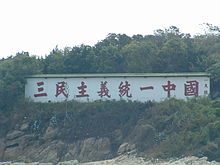 The slogan "Three Principles of the People unite China", written in traditional Chinese, the official language of the ROC, located in Kinmen, directly facing Mainland China
The slogan "Three Principles of the People unite China", written in traditional Chinese, the official language of the ROC, located in Kinmen, directly facing Mainland China
Kinmen is recognized as a national park. Because of its military importance, development on the island was extremely limited. As a result, it is now a popular weekend tourist destination for Taiwanese and is known for its quiet villages, old-style architecture, and beaches. Due to the extensive shelling by the PRC, Kinmen is famous for its Artillery Shell Knives. Local artisans would collect the vast amounts of exploded ordnance and make high-quality knives which are still sought after by chefs and connoisseurs. Kinmen is also home of the locally famous Kinmen Kaoliang liquor, a spirit ranging between 38 and 63 percent alcohol, which is highly appreciated by the Taiwanese. The Kinmen Airport is located on the bigger island.
Politics
The island consistently votes for the Kuomintang (KMT). Until the early 1990s, proponents of Taiwan independence argued that they would consider handing Kinmen over to the PRC in any negotiated settlement. Residents of the island have broadly opposed such measures, fearing the consequences of the PRC government's policies on their standard of living and political freedom.
Townships
Kinmen County is subdivided into six townships:
Name Hanzi Hanyu Pinyin Wade-Giles Tongyong Pinyin Hokkien Pe̍h-ōe-jī English meaning Jincheng Township 金城鎮 Jīnchéng Chin-ch'eng Jīnchéng Kim-siâⁿ-tìn Golden City Jinsha Township 金沙鎮 Jīnshā Chin-sha Jinsha Kim-soaⁿ-tìn Golden Sand Jinhu Township 金湖鎮 Jīnhú Chin-hu Jinhú Kim-ô·-tìn Golden Lake Jinning Township 金寧鄉 Jīnníng Chin-ning Jinníng Kim-lêng-hiong Golden Tranquility Lieyu Township 烈嶼鄉 Lièyǔ Lie-yü Lièyǔ Lia̍t-sū-hiong Heroic Islets Wuqiu Township 烏坵鄉 Wūqiū Wu-ch'iu Wuciou O·-kiu-hiong Black Mound All those townships on Greater Kinmen Island start their names with Jin ("gold"). Lieyu Township encompasses the entire Lesser Kinmen Island, and is the closest to Xiamen. Wuqiu Township comprises Greater Qiu Islet (大坵) and Lesser Qiu Islet (小坵).
Jincheng and Jinsha are the largest of the six townships. Altogether, there are 37 Kinmen villages, three of which – all in Zhen (鎮) – are Li-villages (里); the rest are Cun-villages (村).
Education
In August 2010, National Quemoy University (國立金門大學) was established from the Kinmen Technology Institute.[5] It is located in Jinning Township, Kinmen.
Gallery
-
Calligraphy by former President Chiang Kai-shek etched on a rock in Kinmen reads, "Forget not what happened in Jǔ" - an allusion to the Warring States Period when the State of Qi, cornered into the City of Ju by the State of Yan, successfully counterattacked and retook its territory. This is intended as an analogy to the situation between the Republic of China and the People's Republic of China. Other slogans alluding to "retaking the mainland" can still be found in Kinmen.
-
Jincheng, the county seat of Kinmen.
See also
- Administrative divisions of the Republic of China
- Township (Taiwan)
- List of cities in the Republic of China (Taiwan)
- Cross-Strait relations
- Boyu Road
References
- ^ FREDERIC WAKEMAN JR. (1986). GREAT ENTERPRISE: THE MANCHU RECONSTRUCTION OF THE IMPERIAL ORDER IN. University of California Press. p. 114. ISBN 0520048040. http://books.google.com/books?id=8nXLwSG2O8AC&q=prince+of+lu#v=snippet&q=prince%20lu%20exile%20quemoy&f=false. Retrieved 2011-06-06.
- ^ http://www.gwytb.gov.cn:8088/detail.asp?table=Interactions&title=Cross-strait+Interactions+and+Exchanges&m_id=29
- ^ http://www.chinataiwan.org/english/News/zt/tdl/200310/t20031028_121559.htm
- ^ "Construction of Kinmen Bridge begins". Focus Taiwan News Channell. 2011-01-09. http://focustaiwan.tw/ShowNews/WebNews_Detail.aspx?Type=aALL&ID=201101090019. Retrieved 2011-01-09.
- ^ http://www.whatsonxiamen.com/news13843.html
External links and further reading
- Kinmen travel guide from Wikitravel
- Kinmen County Government Official Website
- Complete list of the villages in each township
- Maps of Kinmen
- Satellite image of Greater Kinmen and Lesser Kinmen by Google Maps
- Michael Szonyi, Cold War Island: Quemoy on the Front Line, Cambridge University Press (August 11, 2008), hardcover, 328 pages, ISBN-10: 0521898137 ISBN-13: 978-0521898133; trade paperback, 328 pages, ISBN-10: 0521726409, ISBN-13: 978-0521726405
- "Once a Redoubt Against China, Taiwan’s Outpost Evolves" feature article by Edward Wong and Xiyun Fukada in The New York Times September 16, 2011
 Administrative divisions of the Republic of China(Otherwise known as Taiwan).
Administrative divisions of the Republic of China(Otherwise known as Taiwan).Special municipalities 
Taiwan Province CitiesFujian Province Kinmen · LienchiangSee also: Free Area of the Republic of China.Cities and townships in the Taiwan strait islands of the Republic of China County seats are in BoldTaiwan - Baisha
- Huxi
- Qimei
- Xiyu
- Wang'an
Fukien Kinmen- Jincheng
- Jinsha
- Jinhu
- Jinning
- Lieyu
- Wuqiu
Fujian Province county-level divisions Fuzhou: Gulou District · Taijiang District · Cangshan District · Mawei District · Jin'an District · Fuqing City · Changle City · Minhou County · Lianjiang County · Luoyuan County · Minqing County · Yongtai County · Pingtan County
Xiamen: Siming District · Haicang District · Huli District · Jimei District · Tong'an District · Xiang'an District
Nanping: Yanping District · Shaowu · Wuyishan City · Jian'ou City · Jianyang · Shunchang County · Pucheng County · Guangze County · Songxi County · Zhenghe County
Sanming: Meilie District · Sanyuan District · Yong'an City · Mingxi County · Qingliu County · Ninghua County · Datian County · Youxi County · Sha County · Jiangle County · Taining County · Jianning County
Putian: Chengxiang District · Hanjiang District · Licheng District · Xiuyu District · Xianyou County
Quanzhou: Licheng District · Fengze District · Luojiang District · Quangang District · Shishi City · Jinjiang City · Nan'an City · Hui'an County · Anxi County · Yongchun County · Dehua County · Kinmen*
Zhangzhou: Xiangcheng District · Longwen District · Longhai · Yunxiao County · Zhangpu County · Zhao'an County · Changtai County · Dongshan County · Nanjing County · Pinghe County · Hua'an County
Longyan: Xinluo District · Zhangping City · Changting County · Yongding County · Shanghang County · Wuping County · Liancheng County
Ningde: Jiaocheng District · Fu'an City · Fuding City · Shouning County · Xiapu County · Zherong County · Pingnan County · Gutian County · Zhouning County■ = Sub-provincial city ■ = Prefecture-level city
*Kinmen is administered as a county by the Republic of China, but claimed by the PRC.Categories:- County-level divisions of Fujian
- Ports and harbours of the Republic of China
- Territorial disputes of the People's Republic of China
- Territorial disputes of the Republic of China
- Kinmen
-
Wikimedia Foundation. 2010.

